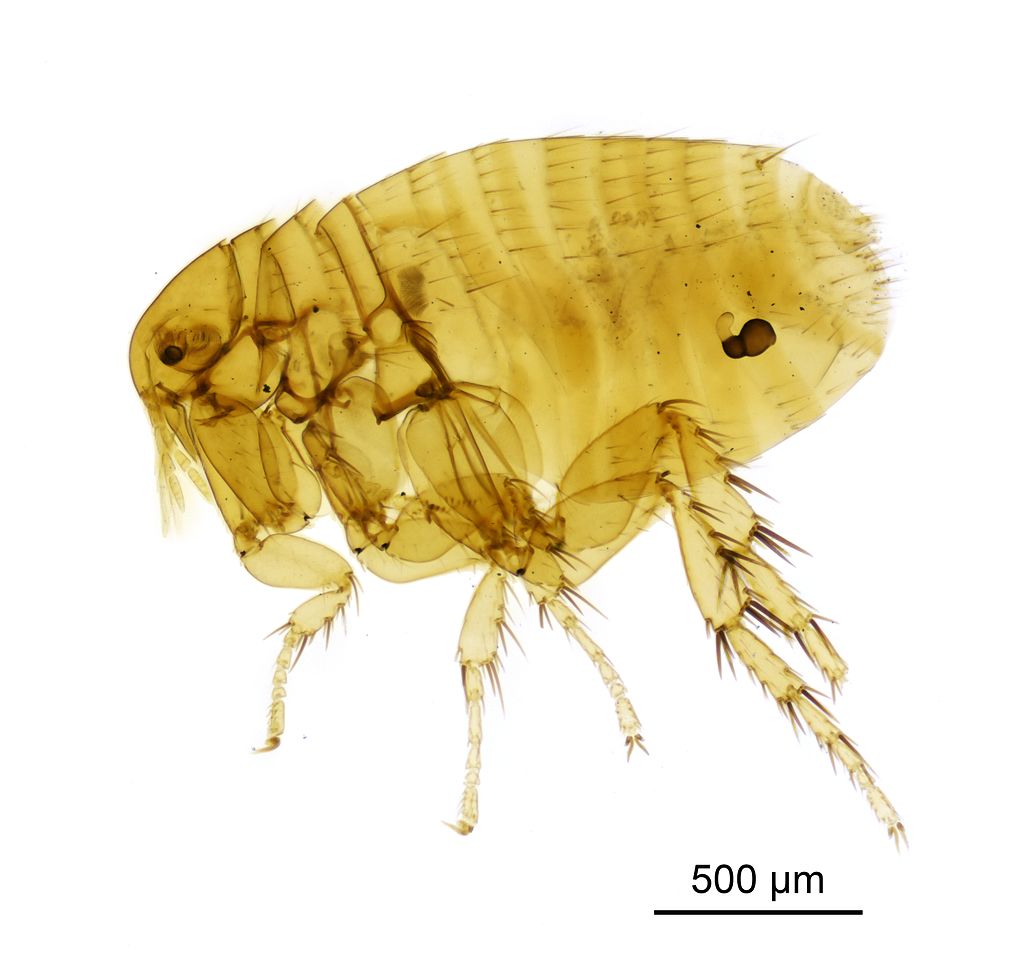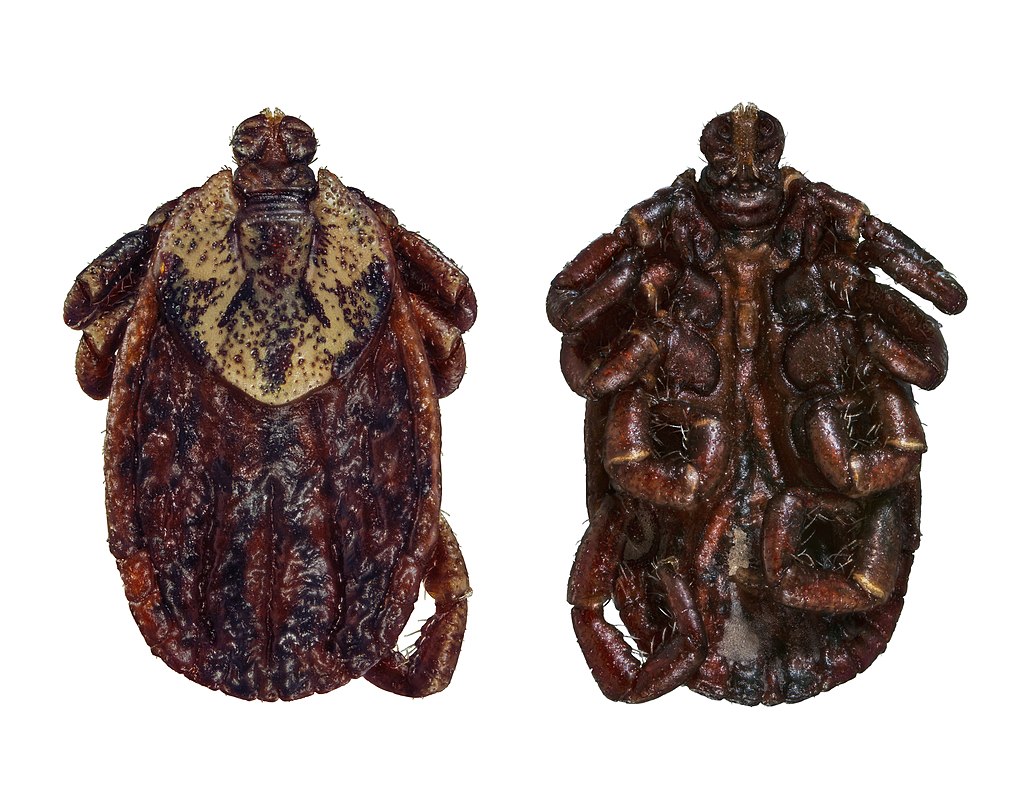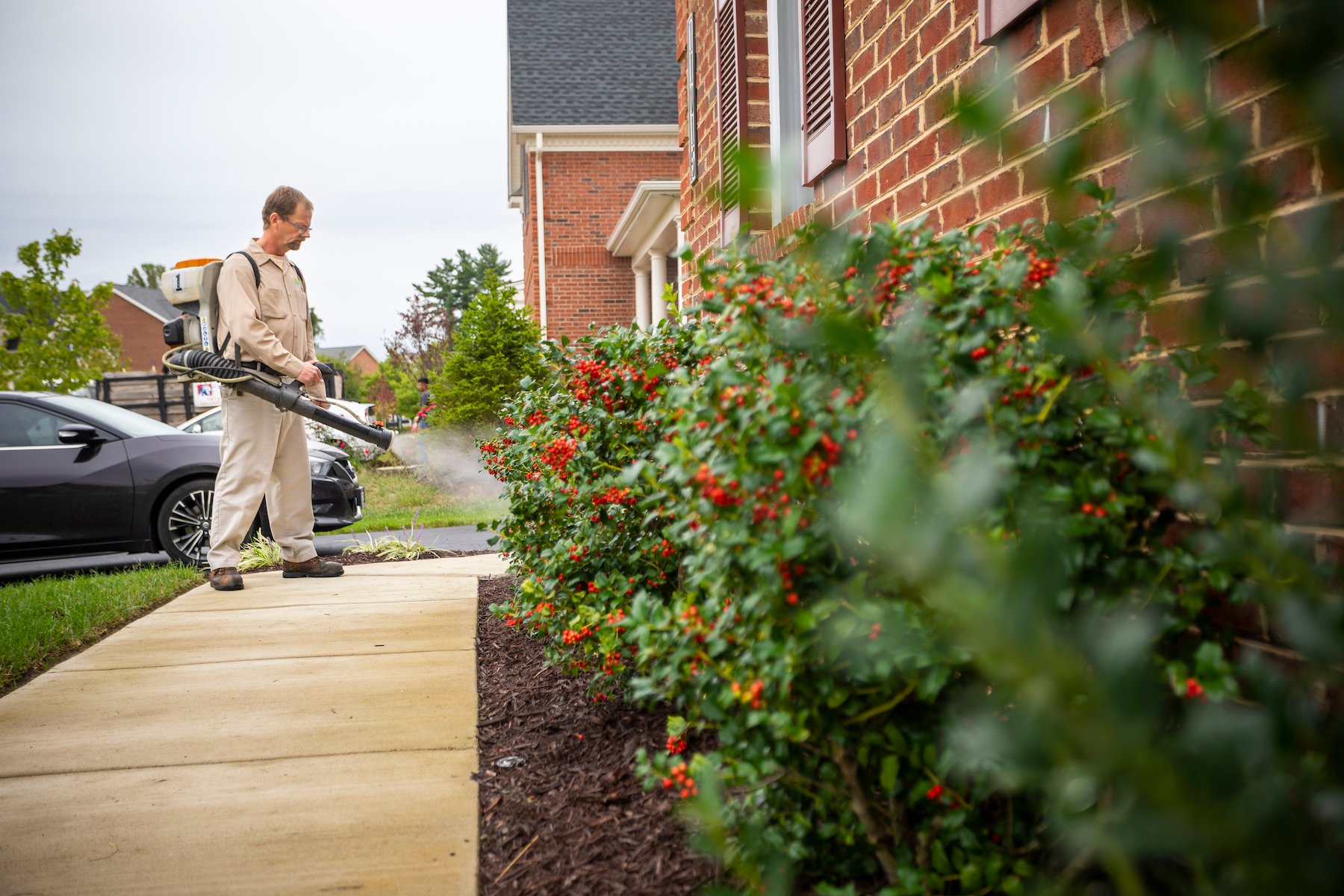Are Flea and Tick Yard Treatments Safe for Pets?
If your dog has ever had fleas, then you know how hard it can be to remove those pests from your best friend, as well as your home. And if you’ve found a tick or two on your pet, you know they can appear without warning.
Your goal is to not only keep the fleas and ticks outside, but to also keep them off of your pets. A flea and tick lawn treatment in Central or Southern Maryland can help keep these nasty nuisances as bay.
But you may be wondering if lawn flea and tick treatments are safe for pets.
Let’s look at what flea and tick treatments entail and how they can safely help save your pets from infestation.
Fleas and Ticks in Your Yard: A Closer Look
First, let’s talk about these pests.
Fleas are wingless insects with long, flat bodies that feed on blood from pets, wild animals, and people.  Ticks are actually considered arachnids. They are dark brown or black and, like fleas, also seek blood from animals and people. Drinking blood actually allows them to produce and lay more tick eggs.
Ticks are actually considered arachnids. They are dark brown or black and, like fleas, also seek blood from animals and people. Drinking blood actually allows them to produce and lay more tick eggs.  Both pests become active when daytime Maryland temperatures remain consistently at or above 50 degrees Fahrenheit. Also at this time, more wild animals start foraging and moving about -- think deer, rabbits, squirrels, mice, possum, etc. And fleas and ticks hitch rides on these critters as they move in and out of your yard.
Both pests become active when daytime Maryland temperatures remain consistently at or above 50 degrees Fahrenheit. Also at this time, more wild animals start foraging and moving about -- think deer, rabbits, squirrels, mice, possum, etc. And fleas and ticks hitch rides on these critters as they move in and out of your yard.
Then once fleas and ticks go from your yard to your pet and into your house, they can quickly make homes in carpets and furniture. That’s why finding a safe way to kill fleas and ticks in your yard is important.
Fleas and Ticks Can Bring More Than Itches and Scratches
Fleas and ticks can be hard to spot in your yard, so you might not know they are there until you start to see signs from your pets.  It starts with itching and scratching. You might even see some hair missing or have unusually tired cats or dogs. Pets allergic to fleas may also have red skin or bumps.
It starts with itching and scratching. You might even see some hair missing or have unusually tired cats or dogs. Pets allergic to fleas may also have red skin or bumps.
With ticks, they grasp onto your dog’s fur or your pant leg as you walk by. Initially, you may not even know they’re there. You can usually find them if you check your pet’s skin. Ticks are dark and circular. If you don’t see ticks on your skin, you might feel swelling, pain, or even a headache once they’ve been on your skin for awhile, alerting you to their presence.
The worst part about fleas and ticks is they can bring something a lot worse than itches and scratches. They are also a common source of some pretty serious illnesses. Ticks can spread Lyme disease. And fleas can bring typhus or cat-scratch fever, among other things. This is a big reason why using a safe way to kill fleas and ticks in your yard can also save you from the diseases they carry.
Safely Battle Fleas and Ticks in Your Yard
Pet safe flea and tick yard treatments in Central and Southern Maryland typically start when the pests become active, usually April. And they are applied monthly until the pest activity dies down, usually through October.
These treatments consist of a liquid application to the lawn, flower and shrub beds and other harborages near tall grasses and trees. While six applications is ideal for the most control, pest control professionals suggest no fewer than three applications during a season. Flea and Tick yard treatments typically cost between $55 and $69 per application for a 5,000 to 10,000 square foot yard.
Flea and Tick yard treatments typically cost between $55 and $69 per application for a 5,000 to 10,000 square foot yard.
There are a few things to look for when you’re seeking the safest flea and tick control.
Flea and Tick Control Expertise & High-End Products
When looking for a Maryland pest control company to help you battle fleas and ticks in your landscape, you want to hire someone with experience in managing these specific pests.
Companies that stay up to date on application best practices and techniques will be very familiar with product label recommendations and be able to use as little product as possible for maximum results.
These companies are also using pet safe flea and tick yard treatment products. In fact, these products typically include the same active ingredients in the flea and tick shampoo that you bathe your pets in.
Lawn Flea and Tick Control Tips
Your lawn care provider should be able to give you guidance before, during, and after flea and tick applications.
The safe way to kill fleas and ticks in your yard includes giving you guidance on where fleas and ticks hang out and how to keep your pet safe from them.
Fleas and ticks prefer shady spots with cool, moist air, such as woodpiles, shrubs, tall grasses, and leaf piles.
You can limit these pests by keeping your lawn mowed and keeping children’s playsets and dog houses away from woods at the far edges of your property. When exploring in the woods, wearing insect repellant and long pants or tall socks can help cover areas these pests usually latch onto. Your pest control professional should also provide insight on when to let your pets outside after a flea and tick treatment. After granular applications, pets can go outside immediately. After liquid applications, you should wait until your lawn is dry before letting pets out. This usually takes about 20 to 30 minutes.
Your pest control professional should also provide insight on when to let your pets outside after a flea and tick treatment. After granular applications, pets can go outside immediately. After liquid applications, you should wait until your lawn is dry before letting pets out. This usually takes about 20 to 30 minutes.
Stop Fleas and Ticks Safely
When fleas and ticks invade your pets, you, and your space, getting rid of them can be an overwhelming process.
Understanding how these pests operate and working on preventing them are the best ways to maintain control.
Natural Green wants to help you choose a pet safe flea and tick yard treatment in Central or Southern Maryland. We can educate you on the process, the products, and safety measures we take and that you can take to ensure a flea- and tick-free yard and home and happy pets.
Want to learn more about getting fleas and ticks out of your Central and Southern Maryland yard? Get started today with a free quote. We’ll review your options together so you can make a great choice. Then you can let Bingo outside without worry.
If your dog has ever had fleas, then you know how hard it can be to remove those pests from your best friend, as well as your home. And if you’ve found a tick or two on your pet, you know they can appear without warning.
Your goal is to not only keep the fleas and ticks outside, but to also keep them off of your pets. A flea and tick lawn treatment in Central or Southern Maryland can help keep these nasty nuisances as bay.
But you may be wondering if lawn flea and tick treatments are safe for pets.
Let’s look at what flea and tick treatments entail and how they can safely help save your pets from infestation.
Fleas and Ticks in Your Yard: A Closer Look
First, let’s talk about these pests.
Fleas are wingless insects with long, flat bodies that feed on blood from pets, wild animals, and people.  Ticks are actually considered arachnids. They are dark brown or black and, like fleas, also seek blood from animals and people. Drinking blood actually allows them to produce and lay more tick eggs.
Ticks are actually considered arachnids. They are dark brown or black and, like fleas, also seek blood from animals and people. Drinking blood actually allows them to produce and lay more tick eggs.  Both pests become active when daytime Maryland temperatures remain consistently at or above 50 degrees Fahrenheit. Also at this time, more wild animals start foraging and moving about -- think deer, rabbits, squirrels, mice, possum, etc. And fleas and ticks hitch rides on these critters as they move in and out of your yard.
Both pests become active when daytime Maryland temperatures remain consistently at or above 50 degrees Fahrenheit. Also at this time, more wild animals start foraging and moving about -- think deer, rabbits, squirrels, mice, possum, etc. And fleas and ticks hitch rides on these critters as they move in and out of your yard.
Then once fleas and ticks go from your yard to your pet and into your house, they can quickly make homes in carpets and furniture. That’s why finding a safe way to kill fleas and ticks in your yard is important.
Fleas and Ticks Can Bring More Than Itches and Scratches
Fleas and ticks can be hard to spot in your yard, so you might not know they are there until you start to see signs from your pets.  It starts with itching and scratching. You might even see some hair missing or have unusually tired cats or dogs. Pets allergic to fleas may also have red skin or bumps.
It starts with itching and scratching. You might even see some hair missing or have unusually tired cats or dogs. Pets allergic to fleas may also have red skin or bumps.
With ticks, they grasp onto your dog’s fur or your pant leg as you walk by. Initially, you may not even know they’re there. You can usually find them if you check your pet’s skin. Ticks are dark and circular. If you don’t see ticks on your skin, you might feel swelling, pain, or even a headache once they’ve been on your skin for awhile, alerting you to their presence.
The worst part about fleas and ticks is they can bring something a lot worse than itches and scratches. They are also a common source of some pretty serious illnesses. Ticks can spread Lyme disease. And fleas can bring typhus or cat-scratch fever, among other things. This is a big reason why using a safe way to kill fleas and ticks in your yard can also save you from the diseases they carry.
Safely Battle Fleas and Ticks in Your Yard
Pet safe flea and tick yard treatments in Central and Southern Maryland typically start when the pests become active, usually April. And they are applied monthly until the pest activity dies down, usually through October.
These treatments consist of a liquid application to the lawn, flower and shrub beds and other harborages near tall grasses and trees. While six applications is ideal for the most control, pest control professionals suggest no fewer than three applications during a season. Flea and Tick yard treatments typically cost between $55 and $69 per application for a 5,000 to 10,000 square foot yard.
Flea and Tick yard treatments typically cost between $55 and $69 per application for a 5,000 to 10,000 square foot yard.
There are a few things to look for when you’re seeking the safest flea and tick control.
Flea and Tick Control Expertise & High-End Products
When looking for a Maryland pest control company to help you battle fleas and ticks in your landscape, you want to hire someone with experience in managing these specific pests.
Companies that stay up to date on application best practices and techniques will be very familiar with product label recommendations and be able to use as little product as possible for maximum results.
These companies are also using pet safe flea and tick yard treatment products. In fact, these products typically include the same active ingredients in the flea and tick shampoo that you bathe your pets in.
Lawn Flea and Tick Control Tips
Your lawn care provider should be able to give you guidance before, during, and after flea and tick applications.
The safe way to kill fleas and ticks in your yard includes giving you guidance on where fleas and ticks hang out and how to keep your pet safe from them.
Fleas and ticks prefer shady spots with cool, moist air, such as woodpiles, shrubs, tall grasses, and leaf piles.
You can limit these pests by keeping your lawn mowed and keeping children’s playsets and dog houses away from woods at the far edges of your property. When exploring in the woods, wearing insect repellant and long pants or tall socks can help cover areas these pests usually latch onto. Your pest control professional should also provide insight on when to let your pets outside after a flea and tick treatment. After granular applications, pets can go outside immediately. After liquid applications, you should wait until your lawn is dry before letting pets out. This usually takes about 20 to 30 minutes.
Your pest control professional should also provide insight on when to let your pets outside after a flea and tick treatment. After granular applications, pets can go outside immediately. After liquid applications, you should wait until your lawn is dry before letting pets out. This usually takes about 20 to 30 minutes.
Stop Fleas and Ticks Safely
When fleas and ticks invade your pets, you, and your space, getting rid of them can be an overwhelming process.
Understanding how these pests operate and working on preventing them are the best ways to maintain control.
Natural Green wants to help you choose a pet safe flea and tick yard treatment in Central or Southern Maryland. We can educate you on the process, the products, and safety measures we take and that you can take to ensure a flea- and tick-free yard and home and happy pets.
Want to learn more about getting fleas and ticks out of your Central and Southern Maryland yard? Get started today with a free quote. We’ll review your options together so you can make a great choice. Then you can let Bingo outside without worry.
Share This
Topics: Pest Control
This is dummy CTA text


